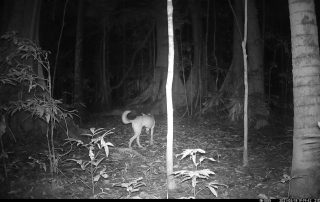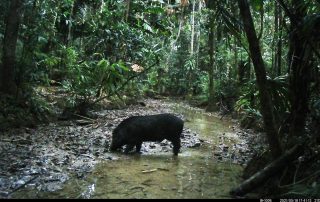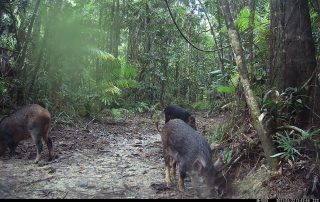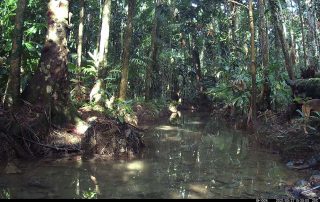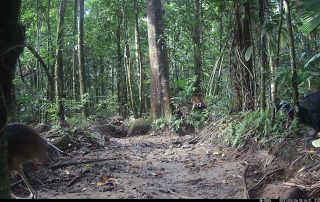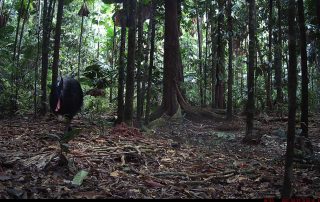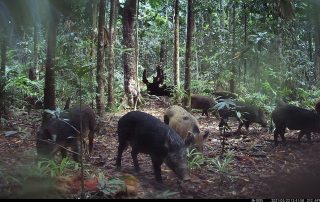Daintree Rainforest Camera Traps – May 2021, accrued 56-cassowary sightings, 29-dingoes and 84-feral pigs. Against the cumulative monthly average, cassowary numbers were 23% down, dingoes were 13% down and feral-pigs were also down by 17%. Against May of the preceding year, however, cassowaries were 69% up, dingo numbers were 71% higher and feral-pig sightings decreased by 12.5%. Seven, of the twelve camera traps, failed to work for either half or all of the month because of technical faults, so the drop in numbers is not necessarily disproportionate.
Image highlights from May
A couple of unexpected revelations from two of the Camera Traps across May 2021, show an adult female cassowary, Prudy, vocalising and in another, Big Bertha, striding purposefully through the rainforest at 1.37-AM. It was full-moon, but the reflectiveness of her eye-shine shows a quality normally attributed to nocturnal fauna. This is not the first time I have witnessed cassowaries moving about with competence at night, having conducted night-tours over twenty-years, but it is the first time a camera-trap has captured the behaviour in eighteen-months of data-collection from twelve camera-traps.
The Centre for Invasive Species Solution’s 2014 case-study entitled Feral pig management in tropical rainforests of Queensland contends that feral pigs do not have a strong impact on any of the measured aspects of rainforest dynamics (eg earthworm biomass, soil moisture, soil compaction, litter biomass, litter moisture, plant seedlings, plant saplings and trees) and that seasons had a greater impact on rainforest dynamics than feral pigs in both the fenced and unfenced plots. The study also reports that:
Poison baiting, however, has the potential to be an effective management tool if non-target issues are resolved with an aid of HogHopper™.
The Invasive Animals Cooperative Research Centre (IA CRC) undertook non-toxic Boar Buffet® then HogHopper™field trials in several different Australian habitats to ensure that feral pigs could learn how to use the device in the wild. The trials also provided an opportunity to identify which non-target species could access bait prior to embarking on the final field efficacy trial. During the Daintree NP trial a dingo accessed the Boar Buffet® (push door), hence the HogHopper™ (lift door) was designed. Trials showed that the HogHopper™ was able to prevent all non-target species from accessing 1080-laced barley or toxic PIGOUT® and was able to reduce feeding feral pig populations by 90-100%.
However, one-hundred-and-eighty-million-years of evolutionary refinement have forged an ecosystem of astonishing vitality and specialisation. The phenomenally complex root structure is so comprehensively interwoven, with its 4,000-described species of plant and their corresponding micorrhizal communities, that the entirety of rainforest product is held within a closed system for recycling. In their relentless search for protein, an estimated 60,000-feral-pigs within the Wet Tropics World Heritage Area (WTWHA) dig for earth-worms across twelve-hours of every day, devastating the integrity of this highly-refined root structure and allowing massive quantities of rainforest product to be lost from these gaping wounds of broad-scale feral-pig disturbance. From the tip of Cape York down to Bundaberg and across the eastern-expanse of the Great Dividing Range, the relentless excavations of an estimated six-million feral-pigs ensures that the Great Barrier Reef is continuously polluted by soil deposition. Boars force male cassowaries off their nests to devour the eggs and feral-pig droves predate upon juvenile cassowaries. Feral-pigs also attract pig-hunters, with their menacing pig-dogs, which are often released illegally into WTWHA rainforest causing carnage across the rainforest estate with casualties beyond feral-pigs.
Daintree Rainforest Foundation Ltd and its Daintree Rainforest Fund have been registered by the Australian Charities and Not-for-profits Commission and successfully entered onto the Register of Environmental Organisations. Donations made to the public fund are eligible for a tax deduction under the Income Tax Assessment Act 1997.









